History-making happens when you don’t expect it.
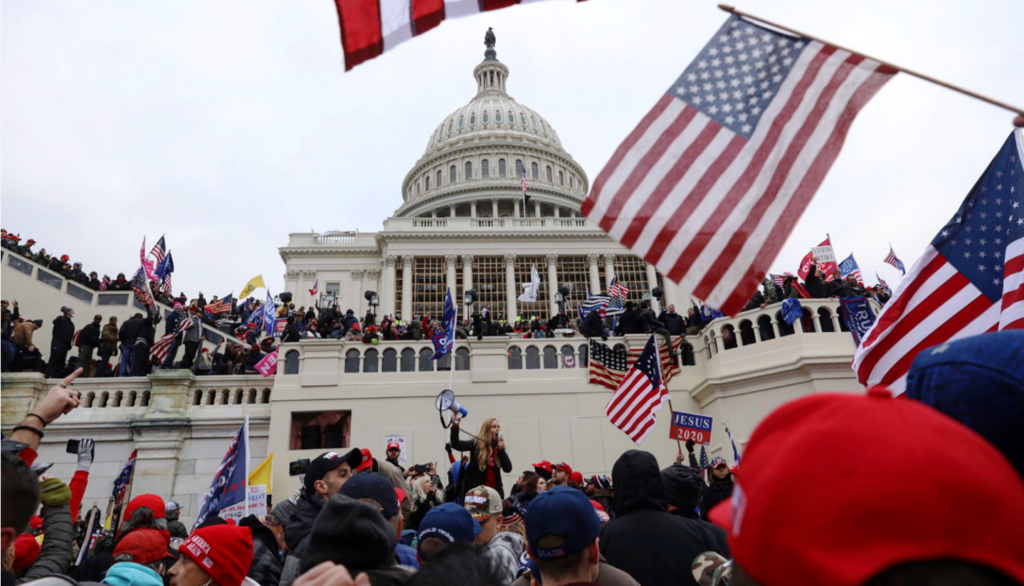
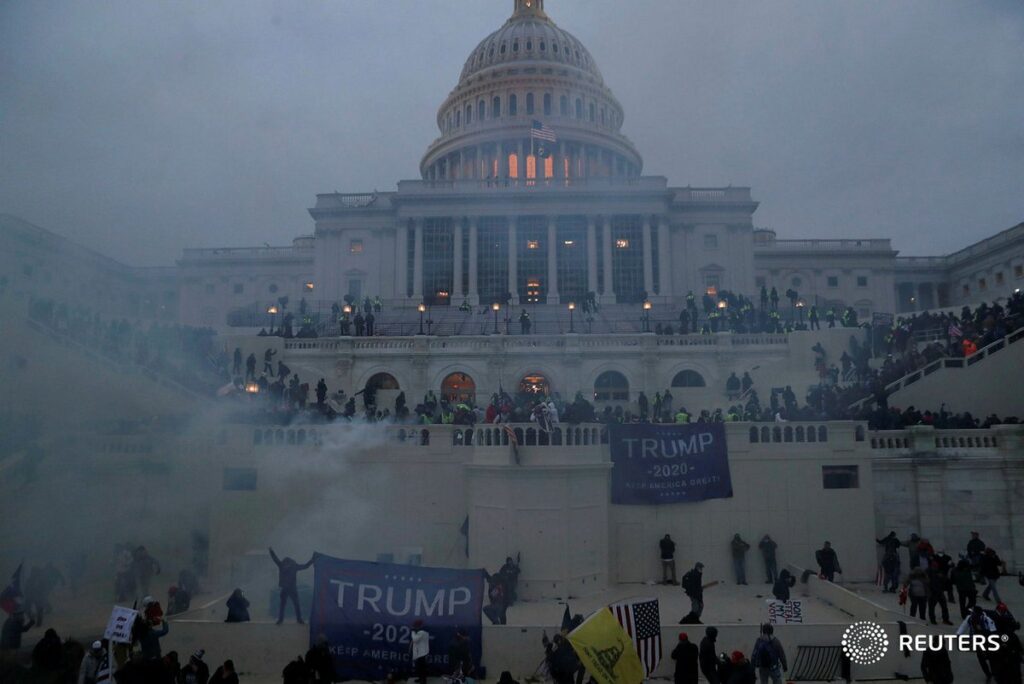
What to “make” of the occupation of the U.S. federal Capitol grounds, in Washington, in the afternoon and into early evening, Jan. 6, 2021?
My immediate impression. This will be remembered as a major, historic, ‘landmark’ moment in history. A moment ranking with the most historic of my adult lifetime so far.
As a protest, and as protests go, it was a stunning success. The occupation of central government building by unarmed protestors? Wow.
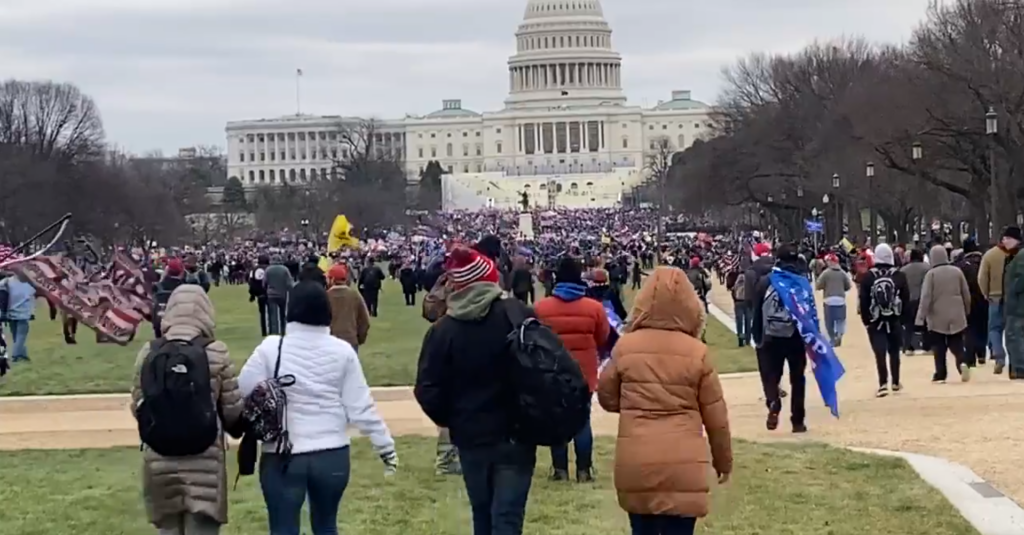
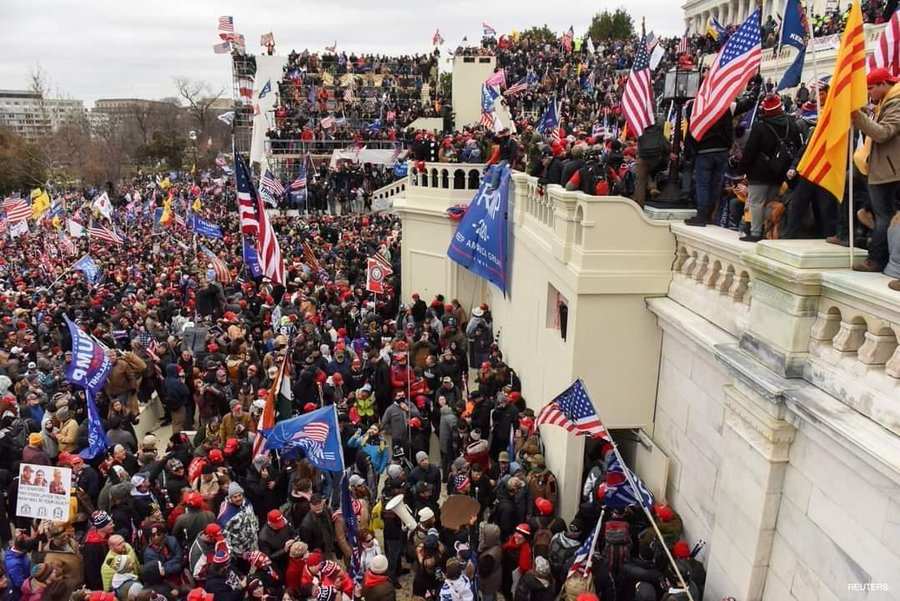
Also a humiliation, if there ever was one, for the U.S. federal government.
The following was written about 48 hours after the event. Thoughts on context for this moment in history, how such as dramatic as this comes to happen, and then some notable scenes from the occupation.
(original: 2000 words) (updated, Jan. 9: now 3300 words.)
____________
Impressions
Let me put it all forward here: I would go as far as to say that the occupation of the United states Congress’ sprawling Capitol grounds is the kind of thing on which national mythologies are based.


To use an obvious comparison: Who would have thought, at the time, that the illegal deeds of a few rascals and malcontents at Boston Harbor, with their dumping of tea from a merchant vessel, would survive so long?
Numbers reportedly in the hundreds of thousands, a morning political rally at the Washington Monument area near the South Lawn of the White House, a certification vote of the electors of the various states, including disputed states, with many Senators and House members objecting due to suspicion of fraud. A spontaneous occupation of the Capitol grounds. It was really as if taken from a movie.
It may be an entirely overly bold to see the hours-long occupation of the Capitol grounds and the successful disruption of the Congressional certification of the presidential vote as a “a major, historic landmark moment.” Of course none can tell. But the purpose of the words you are reading, whenever you may be reading them (hello, readers of the distant future, if any — did drone delivery ever happen?), is to record thoughts and impressions in the immediate aftermath of the event.
There was history in the air. Whenever ordinary people feel compelled to take radical action, the raw-material of history are there.
Declaring something ‘historic’ means little without pinning something to it more. (‘Historic’ can, very often is, like the word ‘very,’ a pointless emphasizer.) If it was ‘historic,’ was it is more like a ‘beginning’ of something, or an ‘end’ to something?

While it was a humiliation for the U.S. federal government and its prestige (I think that is clear), it is not quite the symbol of 1989 in the European-Communist bloc.
And as for blow to U.S. prestige: When the late May and June 2020 “Black Lives Matter” violent protests were going on (more on these shortly), I said the same. Major protests, encouraged from the top, including violence, “riots” (a now-politicized word, sadly), and looting in major cities for weeks? Please.
But the occupation of the central of government, even as a one-off political protest action, may be an even bigger deal (than the weeks of mid-2020 riots with their untold billions in damages).
If I know nothing else about history, I know that historical narratives change over time. The way an event is remembered after one week, one month, one year, one decade, one century, is always and inevitably different, sometimes radically so, from what people felt at the moment. Hence the purpose of my writing here.
As I write, not forty-eight hours have passed. One cannot wrap everything up “with a neat bow” in 48 hours, and we are dealing here with historical cycles, historical ‘arcs,’ that are yet to play out.
____________
On Historical Arcs
It felt like 2020 was the year “we” (and here I mean most of the ex-NATO bloc and certain foreign cultural-political satellites) lost our tether to reality.
It is important to keep firm the tether to reality. Sometimes it slips. When it slips at the national and international level, we can only blame it on a distinct failure of leadership. Not mean a handful of nominal public officials, but the whole broad leadership class.
(I view the broad leadership class as guilty of something like treason in 2020, for wildly overplaying a flu virus, terrifying half the people, presiding over, encouraging, even demanding immense self-inflicted social-economic damage, and then refusing to admit they were wrong about any of it, despite being wrong from the start on basically all of it. I was optimistic that good data would win out, that the damage could be limited, and that lessons about Panic-as-social-phenomenon could be learned and used in the future. But even now, ten months later, it just hasn’t happened. It makes me genuinely sad, in addition to certain other emotions.)
Analyzing annus horribilis 2020 and what led to such catastrophic public policy failures as getting stuck in an endless cycle of overreaction to a flu-virus (via the frankly crazy policy of Lockdowns and all kinds of other disruptions), is a tall order. It will suffice to say that 2020 was not as sudden a break from the past as it may seem, but a sudden breakthrough of existing trends, with the Lockdowns in part as a power-play. The same trends that gave us the Virus Panic of 2020, and its politicization, are also long-run causes for the historic moment of the “Storming of the Capitol.”
One of the leading historical “trends” of the 2010s, evident both early in the decade and more dramatically in the middle and later parts of the decade, was the feeling that the leadership class in the West had failed and had discredited itself. The same story all across the West. It was followed coherent, or semi-coherent, in-system political revolts against the “Elite.” This was so-called “Populism,” a phenomenon international in scope and predating Trump.
Populism, as it somewhat lamely called, is clearly the base-layer cause of the historic moment when protestors “stormed the Capitol” and occupied it for hours, causing the haughty Congresspersons to evacuate and the presidential vote to be disrupted.
What was 2010s “Populism”? There was never any agreement on any clear definition, in part because those with the intellectual framework to analyze it were so uncomfortable with it. Most often it was dismissed by the Good People as something for the rubes, the “poorly educated,” and delusional people. Maybe dupes of Trump (or insert local populist figurehead). But for purposes here, it was a widespread feeling of system illegitimacy. This is a radical position. If your system is illegitimate, you want it gone, replaced by a better one. You may not be able to enunciate exactly what you want, but you know the current system is bad for you and your kin, and you want it gone.
The Soviet bloc in the late 1980s: The “populists” of their time, and anti-system malcontents of all kinds, pushed on a sclerotic, declining system. It all came down with almost no shots fired (except in Romania).
Populism manifested in the mid-late 2010s in all different ways, far too broad to comment on now.
Now for 2020. The energetic embrace of Lockdownism, with so many good people and otherwise-smart people surrendering their critical thinking abilities (both wildly overestimating the danger posed by one flu virus and also ignoring consequences a Lockdown policy and a top-down Panic drumbeat would have), had predictable consequences. The frustrations stemming from major life disruptions gave rise to the kind of anger that would lead a man to be willing to “storm the Capitol.” But they gave rise to other protests far before that: The weeks of Black Lives Matter protests.
The Black Lives Matter protests/riots came in the summer. The actual trigger event was nominally unrelated to the Lockdown, but given how trifling and ambiguous it was, and given that it aligned exactly with the opening of states from lockdowns, and with the Memorial Day weekend symbolic opening of summer — after robbing people of 2.5 months of spring — the protests/looting/etc. were just clearly caused by the Lockdowns. The civic cult around The Virus was too taboo, but people were suffering, frustrated, and wanted action. Fun. To gather with people. To meet people. Everything was disrupted, canceled, or closed. With seemingly nothing done against them, and the most powerful forces in society all almost instantly celebrating the protests, they continued. Why wouldn’t they?
But there was a dark side: Images and video of the weeks of riots, arsons, vandalism were broadcast nationally and internationally, and were humiliating. The statue-attacking crusade was all the more bizarre and a terrible blow for prestige and any pretense of civic unity. The statue-attacking crusade was deeply troubling to me as it was going on. And this, too, was not new, but had been a movement ongoing in the 2010s. In its basic mechanics it was identical to the Cultural Revolution of China of the late 1960s.
I observed some of these late May and June protests up close, including when they expanded to open looting, mass vandalism targeting all symbols of the White Christian Male everywhere, and limited-scale anarchy including some small arsons. Not much compared to the race riots of the 1960s, but still terrible for prestige: For weeks, months, there was some degree of loss of control over entire city blocks in downtown Washington. A strange sight to see, but stranger still that political and cultural leaders all took the side of the occupiers and “protestors” (who, again, I can say, from experience, were mostly people looking for a Get Out of Lockdown moral pass; they wanted to meet people, and the protests were street-parties; some among them had excess energy to burn, hence some of the rioting/vandalism).
A lot else happened in between. Flashing forward to January 6, 2021, “Middle America” struck back, and pulled off one of the most dramatic protest successes ever seen on U.S. soil.
_______________
Scenes from the Occupation of the U.S. Capitol
The symbolic disruption of the discussion in Congress on certification of the disputed presidential election results, including those of the crucial disputed states, is one thing. In any era, such a protest success would be major news. But in this digital era, the dramatic, symbolic, and humiliating-to-the-government photo-ops gained by protestors who occupied the grounds were even bigger news.
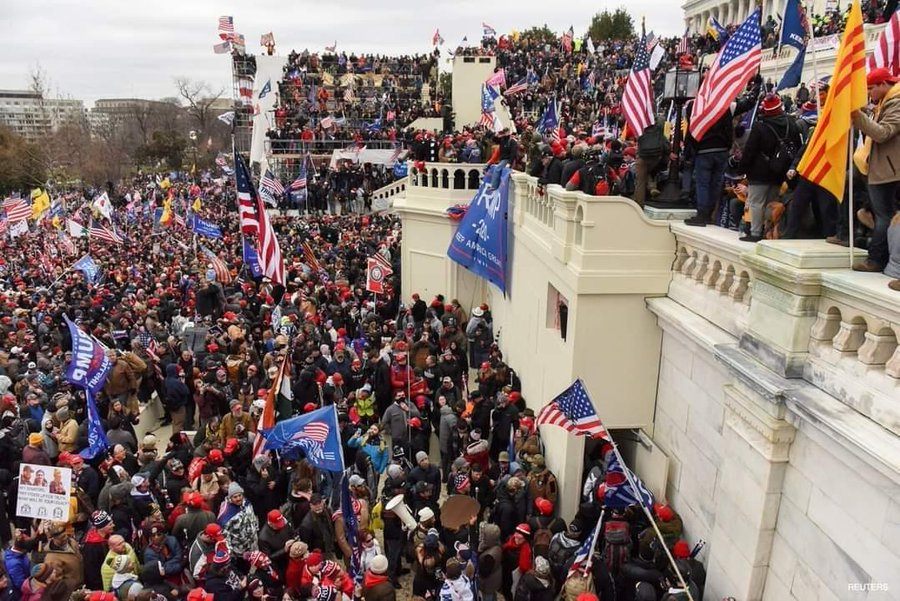
With the Capitol grounds occupied in the classic tradition of protest, which we are told is a sacred right and all, inevitably some hotheads continued pressing their luck and pushed forward. They managed to get in the building itself. I don’t know how many entered the building itself, but that became the story. Of those who were bold enough to enter, one woman was killed by security forces, apparently by gunfire from a secret service agent in unclear circumstances. Meanwhile, thousands continued to occupy the grounds in protest against the alleged election fraud, until nightfall.

Highly notable here is that there was basically no violence or vandalism. Video shows those protestors who got inside, apparently let in by Capitol police who were not prepared for crowd control of this size, mainly staying within the “velvet ropes” once inside the building. They eventually wandered far and wide, but no artwork was vandalized, none of the statues in the rotunda were touched, nothing. (More on the statues later.) I don’t know whether there is a Jefferson statue (I have never even been inside the Capitol), but I’d dare go so far as to say that Jefferson would be proud of this bold action, if one takes him at his own word.
A few papers seemed to be tossed about here and there; a few token items taken, effectively as souvenirs and for symbolic value. This was therefore a true political protest, not comparable to the billions of dollars’ worth of losses to looting as with the events in dozens of cities in mid-2020. (And I personally witnessed looting in downtown Washington; what I saw with my own eyes of looting in process, in real-time, probably amounted to hundreds of thousands of dollars in merchandise, stolen. Much more visible in the immediate aftermath. The boarding across storefronts scarred the cityscape for weeks.)
The protestors who got into the building were basically leaderless and out for pranks. Nancy Pelosi, Democrat, Speaker of the House, elitist, one disdainful of this crowd, was especially the target for the pranks. One redneck got into her office, posed as her desk, defiant, feet up on the table:

A humiliation for the mighty U.S. federal government! A “provincial” like this could get this far! Imagine!
As far as I can tell, the man was eventually pepper-sprayed and left the building, but lived to tell the tale. He boasted of his few minutes’ glory to cameras back outside (in which he insulted Pelosi in colorful language). Whoever he is, whatever his fate may be, the man is now immortal.
The hardy few hundred who entered the building itself were, I take it, stunned by their own success. Of those who ventured in, fun was had by all. A few stuffed shirts were shaken up and lost some of their stuffing. It happens.
Despite no leadership or plan, they seemed to sense what a social-media phenomenon their pictures would be, and they posed for many. There were also apparently professional, news cameramen among those who “stormed” the Capitol.
One guy resembling my friend James (who assures me he was in California at the time), drafted President Gerald Ford into the protest movement: MAGA cap on his head, TRUMP 2020 flag under his arm, Jerry Ford grins — in statue form.
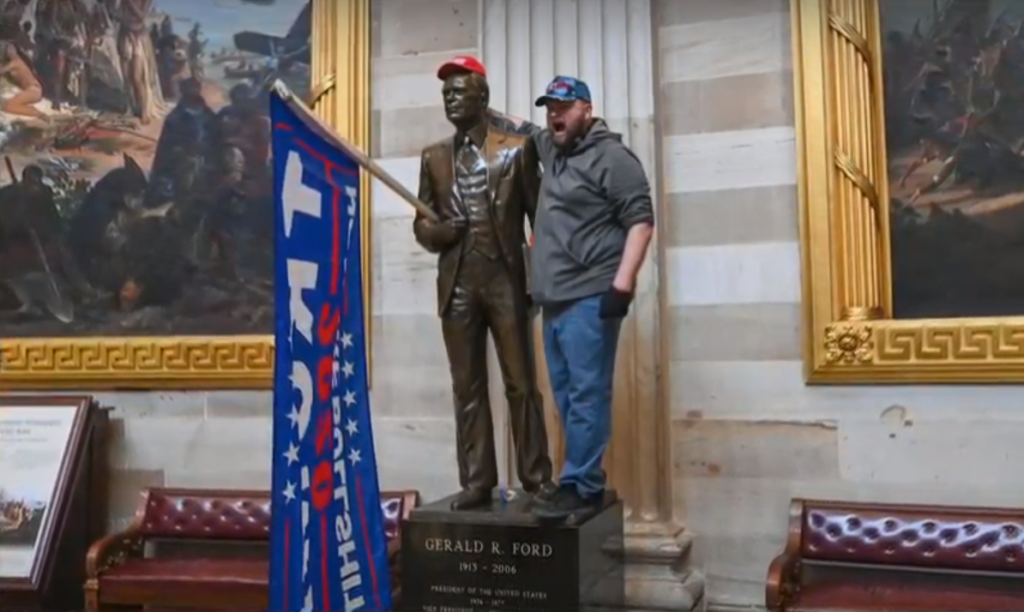
A guy dressed as a buffalo paraded around and posed at the Speaker of the House seat:
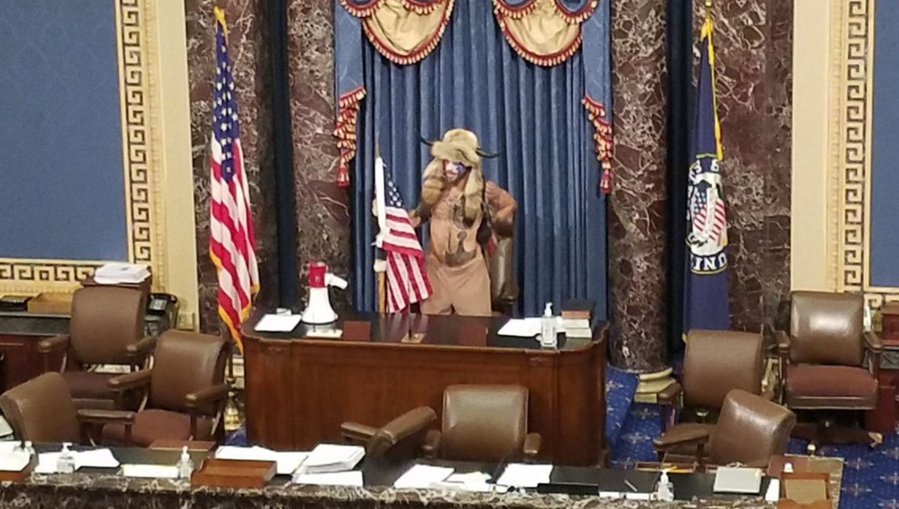
One guy trotted into the pages of history with a wave of the hand and a grin, as he carried off the Speaker’s podium:

The symbolism is striking but ironic: The Populist-Right had just done what the Left had wanted to do all along, in thousands of protests and hundreds of out-and-out riots in mid-2020: To humiliate the government. The mid-2020 protests were much more destructive but despite all of that, were never as symbolically successful as this.
But the narrative-lines are kind of blurry here. I mean, the symbolism of self-professed, hardcore patriots seeming t o be out to humiliate their own government was bound to be confusing. Far off in Syria, anti-regime rebels at Idlib painting a mural of the event:
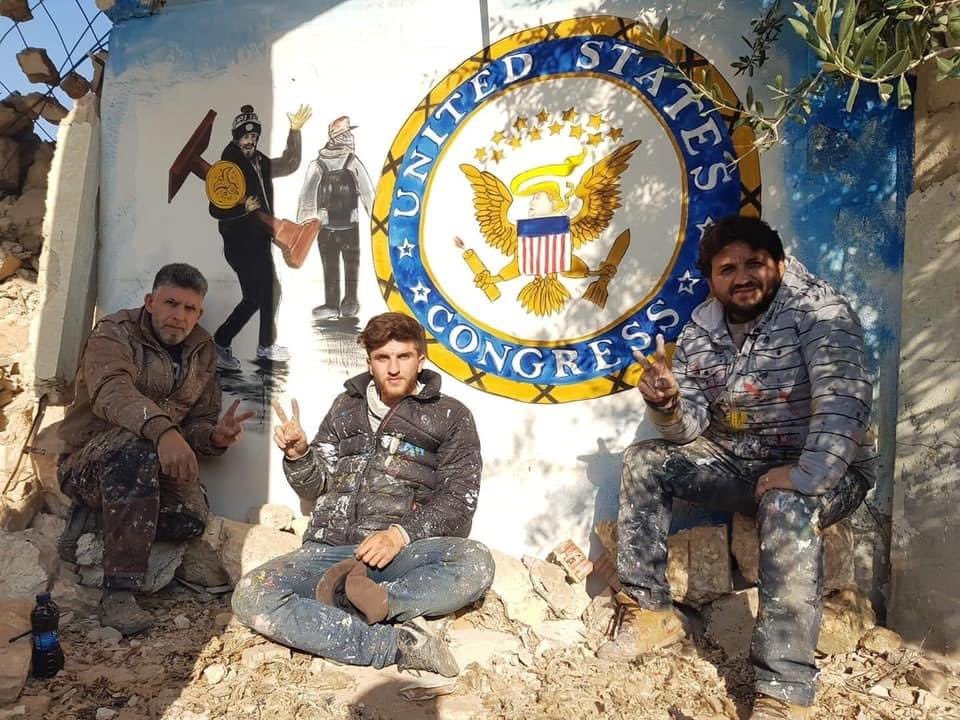
What messaging is this? It appears to be anti-Trump (note the Great Seal of the United States, normally an eagle’s head, is now Trump’s head). These rebels want US assistance, and now with Trump seemingly out for good, maybe they’ll get more. Or so they hope. Others have interpreted the mural to be celebrating the humiliation of the U.S. government just in general terms. These same rebels also made “George Floyd” murals in early June 2020. It’s hard to say what position they have, if any.
Finally, I’ll add that there were all kinds of political flags and banners signaling all kinds of things. This was a symbolic show of strength and resistance, and choices of banners matter. Besides the obvious Trump flags and US flags, the super-majority of the other flags and banners were for (what now may be called) dissident-Right traditions within White-Christian Middle America. There were a few exceptions to this:
There were several grouplets carrying Republic of Vietnam flags (yellow, red stripes). Republic of Korea Taegukki flags (the South Korean national flag) also made appearances; here is one:

That some pro-Trump Koreans were there ties the Occupation of the Capitol grounds event in with something I wrote on at length in the previous post on South Korean politics (“Seoul mayoral races, 2011 to 2021, reminiscences and thoughts“). It’s also, ironically, only possible on U.S. soil that the Korean and Japanese flags would fly side by side at a political rally.
_________________
Premonitions
One day, in the second half of March, maybe about March 20, I was struggling with trying to push back against the descending dark cloud of madness (Lockdown-ism). I got a vision of the future: Chaos and destruction, people fighting each other, turned mad by the Lockdowns. This didn’t seem to have immediately happened, but by about June 2 or June, after several days of major protests, rioting, and looting, I realized the violence had finally come. (It seems there was also a murder spike thereafter for the rest of the year; the inflection point lines up precisely with the start of the protests and continues through the year, amounting to thousands more homicides than 2019.)
It didn’t take any special psychic ability to predict unrest if the government did something as crazy as Lockdowns and months of disruptions to life.
Likewise, something like the January 6th occupation of the U.S. Capitol has long seemed inevitable. The exact form it would take was hard to say. We are always surprised be big events, but they’re rarely truly surprising in the full context of the historical arc of the day.
____________
Symbolism
So they successfully and symbolically disrupted the vote to certify Joe Biden the winner after disputed results in several states, following in the grand tradition of bold protest action of the 20th century. They symbolically humiliated the federal government.
There are more than a few ironies here. Some I see are that many of the “rebels” of the mid-20th century are now the “stuffed-shirts” of the early 21st, the people easily able to be mocked and ridiculed.
They were condemned, of course, which gives rise to a second irony: We are told that these protestors “breached the Temple of Democracy.” Wait a minute. “The People breached the Temple of the People”? Huh!
The imagery of Senators and Congresspeople as so many aristocrats, terrified of their own voters, their own people.
Symbolic occupations of either state-government or federal government buildings are far from unprecedented. I remember, in 2011, when Wisconsin protestors occupied their state Capitol, with explicit political aims/agenda and as an act of political pressure. At the time it was to much acclaim. I remember it. I observed, at somewhat close quarters, some of the Sept.–Oct. 2018 protests about the Kavanaugh Supreme Court confirmation (at which time protestors also occupied part of the Senate, though I didn’t see that). More recently, in the Get out of Lockdown Free Pass protests of mid-2020, some protests were at the Capitol. Most centered angrily on the north end of the White House, and the crowd was belligerent enough to have stormed the White House one the peak days. (I was there watching.)
But this was different in that it was symbolically so dramatically successful. How far a humiliated but powerful government will go to crush their domestic enemies, I don’t know.
_______________
Places I have never set foot
I have never been most of the area the protestors occupied, despite often going down to observe political events in Washington, including protests.
I came within a long stone’s throw of the places the protestors occupied many times. The grounds are very spacious. Sadly, they are mostly dead space to the public. One cannot just wander the grounds of the Capitol, given the (seemingly) tight security. Security is so over-bulky at the best of times, in fact, that it is a considerable annoyance to go around it all.
One of the most dramatic pictures of the day is far to the west of the Capitol building itself, nearly adjacent to the National Mall and a spot always open to the public:
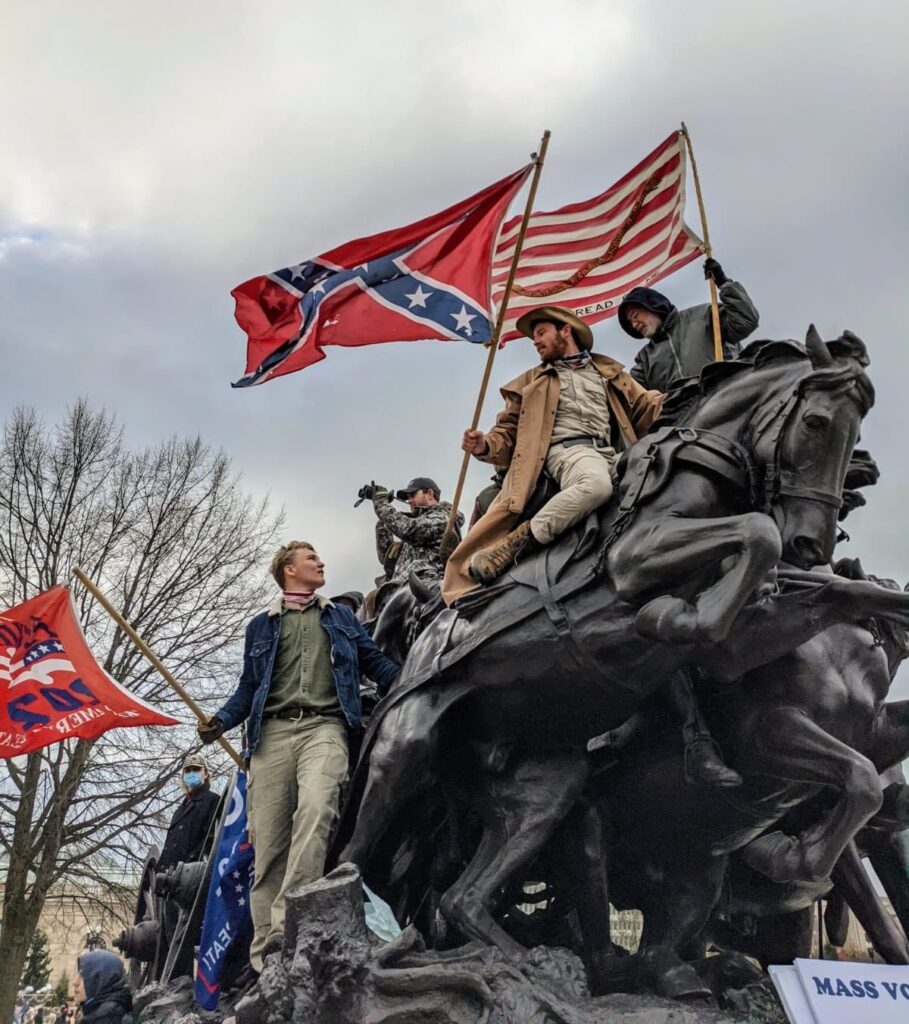
I have been at this statue. I did not ascend it.
I always had an interest in political protests and related events, and even when very busy in the 2016-18 period in Washington I often made a point to stop and look for them. I can tell you with certainty that the kind of mass protest as January 6 is seldom-seen. Middle America people, of which I do consider myself one in some general terms, do not do protests.
The feeling was partially recreated by Rolling Thunder, formerly a yearly protest by motorcycle groups. (In 2019 the local DC government choked them out and they had to end the event, after thirty or so years.)
I was not in Washington for this, and regret it given how historic the moment turned out to be. If I were there, I would have been on the scene. I would not have been among those who entering the Capitol (not my style) after the police detail lifted the gates in response to the uncontrollable crowd demanding to get in (as is my understanding).
____________
Final Thought
Something like this was a long time in coming.
It was not something out-of-the-blue. It is traceable to the historical-arc playing out in the 2010s, and also to the events of 2020, notably the terrible Lockdown policy and the consequences that have followed from that.
These are people who have been subject to hostility by the federal government for decades.
Future realignments are coming. I don’t know when, or how, or where it starts. But when they come, it may be that January 6, 2021, is looked back on as pivotal.
[End.]

Note: Post updated substantially the next day after original posting, but trying to keep with my own reactions.